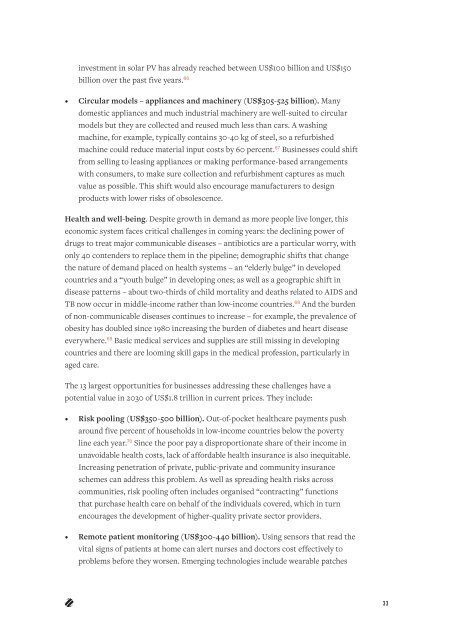BETTER BUSINESS BETTER WORLD
2jxE7K2
2jxE7K2
You also want an ePaper? Increase the reach of your titles
YUMPU automatically turns print PDFs into web optimized ePapers that Google loves.
investment in solar PV has already reached between US$100 billion and US$150<br />
billion over the past five years. 66<br />
• Circular models – appliances and machinery (US$305-525 billion). Many<br />
domestic appliances and much industrial machinery are well-suited to circular<br />
models but they are collected and reused much less than cars. A washing<br />
machine, for example, typically contains 30-40 kg of steel, so a refurbished<br />
machine could reduce material input costs by 60 percent. 67 Businesses could shift<br />
from selling to leasing appliances or making performance-based arrangements<br />
with consumers, to make sure collection and refurbishment captures as much<br />
value as possible. This shift would also encourage manufacturers to design<br />
products with lower risks of obsolescence.<br />
Health and well-being. Despite growth in demand as more people live longer, this<br />
economic system faces critical challenges in coming years: the declining power of<br />
drugs to treat major communicable diseases – antibiotics are a particular worry, with<br />
only 40 contenders to replace them in the pipeline; demographic shifts that change<br />
the nature of demand placed on health systems – an “elderly bulge” in developed<br />
countries and a “youth bulge” in developing ones; as well as a geographic shift in<br />
disease patterns – about two-thirds of child mortality and deaths related to AIDS and<br />
TB now occur in middle-income rather than low-income countries. 68 And the burden<br />
of non-communicable diseases continues to increase – for example, the prevalence of<br />
obesity has doubled since 1980 increasing the burden of diabetes and heart disease<br />
everywhere. 69 Basic medical services and supplies are still missing in developing<br />
countries and there are looming skill gaps in the medical profession, particularly in<br />
aged care.<br />
The 13 largest opportunities for businesses addressing these challenges have a<br />
potential value in 2030 of US$1.8 trillion in current prices. They include:<br />
• Risk pooling (US$350-500 billion). Out-of-pocket healthcare payments push<br />
around five percent of households in low-income countries below the poverty<br />
line each year. 70 Since the poor pay a disproportionate share of their income in<br />
unavoidable health costs, lack of affordable health insurance is also inequitable.<br />
Increasing penetration of private, public-private and community insurance<br />
schemes can address this problem. As well as spreading health risks across<br />
communities, risk pooling often includes organised “contracting” functions<br />
that purchase health care on behalf of the individuals covered, which in turn<br />
encourages the development of higher-quality private sector providers.<br />
• Remote patient monitoring (US$300-440 billion). Using sensors that read the<br />
vital signs of patients at home can alert nurses and doctors cost effectively to<br />
problems before they worsen. Emerging technologies include wearable patches<br />
33


